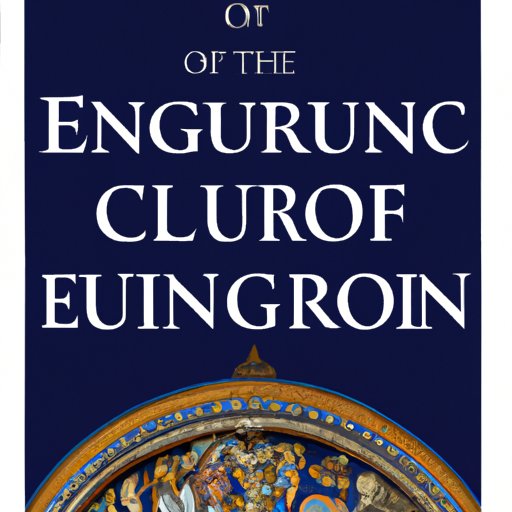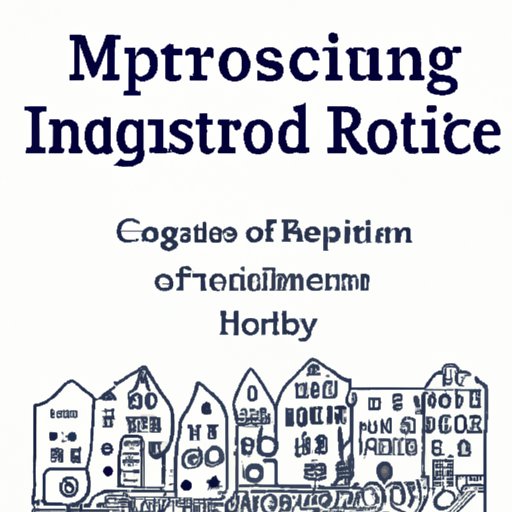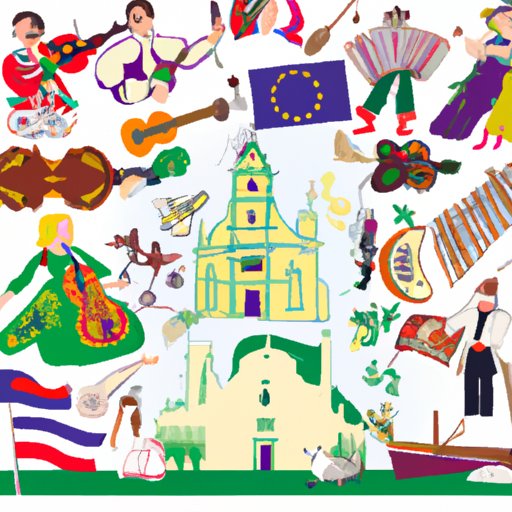Introduction
European culture is a complex blend of many different influences, spanning centuries of history and encompassing a wide variety of countries, peoples, and beliefs. From the picturesque alpine villages of Switzerland to the ancient Greek ruins of Athens, Europe has always been a hub of cultural activity. This article provides an overview of European culture, exploring its regional diversity, popular customs and practices, shared values, artistic expression, and the impact of immigration.

Exploring the Diversity of European Culture: A Guide to the Rich History and Traditions of Europe
Europe is home to a wide range of cultures, each with its own unique set of characteristics and customs. From the rolling hills of Ireland to the vibrant cityscapes of Spain, the continent offers a wealth of cultural experiences. In the north, the Nordic countries of Sweden, Norway, and Finland are known for their outdoor activities, saunas, and Viking heritage. Meanwhile, in the east, Poland and Hungary are renowned for their traditional food, folk music, and vibrant nightlife. In the south, Italy and Greece offer a glimpse into the past with their stunning architecture, archaeological sites, and stunning Mediterranean beaches.
No matter where you go in Europe, you’ll find a unique set of customs and practices. For example, in Germany, it’s common to greet one another with a handshake while in France, two people may kiss each other on both cheeks. In Spain, it’s customary to take a siesta in the afternoon, while in the UK, pubs are a popular place to meet up with friends. In addition, many European countries have their own traditional festivals and holidays – such as Oktoberfest in Germany or Easter in Italy – that add to the richness of the culture.
Understanding the Cultural Values of Europe: An Overview of the Common Beliefs and Values Shared by Europeans
Religion has long played a central role in European culture, with Christianity being the most dominant faith. Roman Catholicism is the predominant denomination in countries such as Italy, Spain, Portugal, and France, while Protestantism is more common in northern Europe. Other religions, including Islam and Judaism, are also practiced throughout the continent.
Family values are important in Europe, with many countries placing emphasis on close-knit families and strong familial bonds. Respect for elders is also important, and children are typically expected to show respect to their parents and grandparents. Social class is also a major factor in European culture, with most countries having a distinct upper class and lower class. Education is highly valued, and many Europeans strive to get a university degree.
An Exploration of Artistic Expression in Europe: How Music, Art and Literature Influence Society
Music, art, and literature are integral parts of European culture. Music styles vary greatly depending on the region, but some of the most popular genres include classical, jazz, and folk. Classical music is particularly popular in Italy, while jazz is often associated with France and the UK. Folk music is also popular in many countries, and can be heard at traditional festivals and celebrations.
Art forms such as painting, sculpture, and photography are also widely appreciated in Europe. Some of the most famous examples of European art can be found in galleries and museums across the continent, showcasing works by masters such as Rembrandt, Michelangelo, and Monet. Similarly, literature has had a profound influence on European culture, with authors such as Shakespeare, Dostoevsky, and Cervantes being considered some of the greatest writers of all time.

Examining the Impact of Immigration on European Culture: How It Has Shaped and Changed Society Over Time
Immigration has been a major source of cultural change in Europe over the past century, with millions of people from around the world flocking to the continent in search of a better life. This influx of people has had a huge impact on European culture, with immigrants bringing new ideas, customs, and beliefs to the countries they settle in. As a result, Europe has become a melting pot of cultures, and many cities now boast a diverse mix of nationalities and ethnicities.
The impact of immigration on culture has been both positive and negative. On the one hand, it has enriched the cultural landscape of Europe, with immigrants contributing to the economy, offering new perspectives, and introducing new cuisines and languages. On the other hand, it has caused some tension between native Europeans and newcomers, with some feeling threatened by the influx of people from different backgrounds.
Conclusion
European culture is a complex and fascinating blend of diverse influences, from its regional customs and practices to its shared beliefs and values. Music, art, and literature have also played a major role in shaping and changing society over time, as has immigration. This article has provided an overview of European culture, exploring its rich history and traditions, as well as its impact on society.
By understanding and appreciating the culture of Europe, we can gain a greater appreciation for the continent and its people. So, the next time you travel to Europe, take the time to explore its culture and discover all it has to offer.
(Note: Is this article not meeting your expectations? Do you have knowledge or insights to share? Unlock new opportunities and expand your reach by joining our authors team. Click Registration to join us and share your expertise with our readers.)
